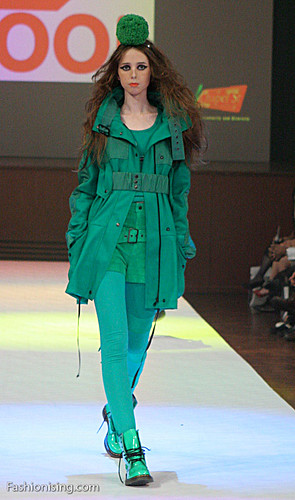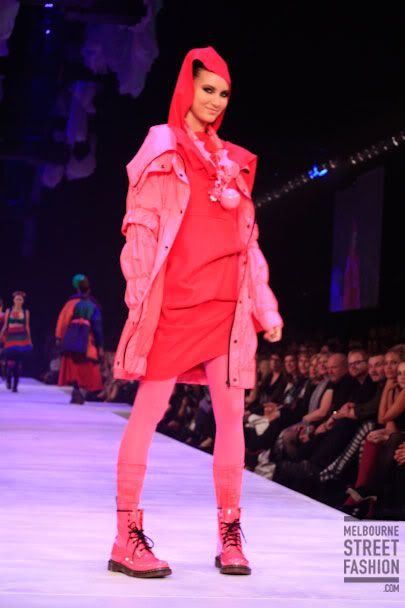Of course, things would be much easier for me if I simply bought a dress pattern. But for some reason this seems much more difficult to me than quickly cutting and resewing sleeves and hems, or pinning a garment on me and then resewing it. Also, I use clothes I already own as templates, modifying the lines to suit what I'm making.
My biggest triumph in this way was probably my Collingwood Boxing Club T-shirt, which was an enormous baggy thing I bought from Savers. I unpicked the sleeves, recut them and the body to match the shape of a T-shirt of mine whose fit I liked, and then sewed them back together.

Oh god, my hair looks like Bret Michaels or something. That pic was from early in 2005.
I also made a dress to wear to my undergraduate valedictory dinner. It was long and bias-cut with spaghetti straps and a cowl neckline; I remember that I made it by laying the fabric on the floor and placing a dress of roughly the same length and shape over the top at a 45-degree angle to act as the template. I made the cowl neck by allowing a generous semicircle of fabric at the top of the dress, which then hung loosely inside the neckline.
There was also my Donatella Versace costume, which I made for my 26th birthday party (the theme was "More dollars than sense"). It was beyond my limited abilities to make a Versace evening dress (like this one Donatella is wearing, left; Saturday Night Live comedian Maya Rudolph is at right), but I wanted to look a bit fancy, so I found an apricot-coloured satin slip/nightgown and an apricot-and-bronze patterned chiffon scarf in an op-shop.
I cut the neckline very low and added a border of the chiffon scarf material, which continued as shoulder straps that fastened in the back. I also cut out triangular panels in the nightgown over the ribs and under the bust and filled them in with panels of the scarf material. It was a real challenge to match the bias cut of the dress with the replacement fabric. I cut a big slit in the skirt over one thigh, and made the skirt longer by adding an edging of the chiffon.

At the party I wore the dress with my skin painted nugget brown and a long white wig. I later wore the dress for an Incredible Melk photo shoot. You can see my hand protectively on my boob to stop it falling out of the dress.
I also don't own a sewing machine or a dressmaker's dummy, so all these things are sewn by hand and I adjust the garment as I am wearing it in front of a mirror.
This week I am attempting another ambitious dressmaking project. It's doubly ambitious because it's an attempt to rescue a failed dressmaking project from last July, when I tried to make a '70s-style 'Grecian goddess' prom dress from some vintage hot-pink gauzy fabric I found at Savers. It's some synthetic fabric – rayon, probably.
It was meant to come out looking similar to this:

But I really screwed up because this was the first time I had attempted to make a dress from scratch without a pattern. I can't quite explain it, but I had imagined very clearly how the dress was going to come together. I could picture the dress in 3D and mentally turn the image around as if it were a Rubik's cube, imagining how I would need to cut and pin and drape the fabric to create this image.
Anyway, I was very rushed and tired and it got to 3am on the night before the prom. I had the dress pinned on me and I was cutting it at the same time, but I accidentally cut it on an angle rather than straight, totally ruining the dress.
But I have decided to attempt to turn it into a '60s-style cocktail dress. Here is a crappy diagram of the way I would like the dress to look. I have drawn the skirt too short; it sits just below the knee.

I have cut out the pieces of the bodice, which looks the same in front and behind. The band goes around the ribs and the skirt begins at the true waist. It is gathered finely at the shoulder, bust and waist – doing this by hand will be the tricky part. Because of the semi-sheer fabric I have allowed two layers in the bodice.
At this stage I'm thinking I'll begin by gathering the shoulder pieces, then sewing the front and back pieces together at the shoulders. Then I will pin the band in place on me and tack it in the front so it sits properly. Once I've put the bodice together I'll attach the skirt. I think there's enough fabric from the old prom dress for more layers in the skirt; I'm thinking about creating a 'self-petticoat' edged in tulle to make the skirt stick out. Then I'll add a side zip.
Time will tell if this project is a success or an abject failure.








